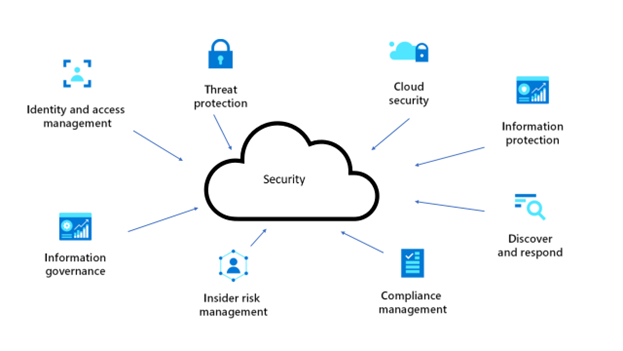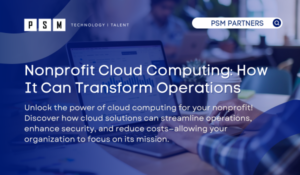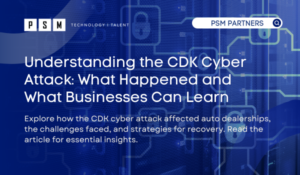Table of Contents
ToggleIn today’s rapidly evolving digital landscape, the cloud has emerged as the backbone of innovation and efficiency for businesses of all sizes. Among the many cloud service providers, Microsoft Azure stands tall, offering a comprehensive suite of tools and services to enable organizations to transform and grow. However, the digital utopia painted by the cloud revolution also comes with its own set of challenges, primarily centered around security. In this blog post, we delve into the crucial topic of security in Microsoft Azure and why it’s imperative for everyone to adopt a “security-first” mindset.
The Azure Advantage: Power and Potential

Microsoft Azure isn’t just a platform for storing and accessing data; it’s a dynamic ecosystem that empowers businesses to develop, deploy, and manage applications and services on a global scale. From virtual machines to AI-driven analytics, Azure provides a versatile toolkit for companies to streamline operations, scale effortlessly, and innovate like never before. However, as the saying goes, “With great power comes great responsibility,” and this applies perfectly to the realm of cloud security.
Fostering a Security-First Mindset: Best Practices and Resources in Microsoft Azure
In light of our recognition of the pivotal role security occupies within the realm of Microsoft Azure, it becomes imperative to delve deeper into actionable strategies for businesses to embrace a steadfast “security-first” ethos:
- Education and Training: Fortify Your Team’s Expertise
Elevating your team’s security prowess begins with a comprehensive understanding of the latest security best practices and vulnerabilities. Regular training sessions can help employees understand the potential threats and how to mitigate them effectively. Ingrain a culture of continuous learning by offering resources such as Microsoft’s Security Training and Certification, which provides a range of courses covering diverse security domains. Regularly scheduled training sessions not only empower employees with insights into potential threats but also equip them with effective countermeasures.
In addition to educating employees about security best practices and potential threats, it’s equally crucial to equip them with the knowledge of how to respond in the event of an incident or if they inadvertently interact with a malicious link. Establishing a clear and comprehensive incident response plan that ensures employees possess a precise roadmap. This proactive approach not only empowers them to thwart potential security breaches but also instills a sense of confidence in navigating complex cyber situations. By staying abreast of evolving security landscape, your team becomes a resilient bulwark against emerging risks.
2. Continuous Monitoring: Vigilance as a Practice
Understand that security isn’t an isolated event but an ongoing commitment. Utilize Azure’s formidable monitoring capabilities to foster a state of perpetual vigilance. Leverage Azure Monitor, a comprehensive solution offering a unified view of your Azure environment’s performance and security. By configuring alerts through Azure Security Center, you can promptly respond to anomalous activities and potential threats. This proactive approach ensures that any deviations from the norm are swiftly identified and mitigated, minimizing the impact of security incidents.
3. Strong Authentication and Access Control: Shielding Your Assets
Augment your security posture by enforcing multi-factor authentication (MFA) and stringent access controls. Azure Active Directory (Azure AD) provides a robust foundation for identity and access management. By implementing Azure AD Conditional Access policies, you can tailor access requirements based on contextual factors, bolstering security while maintaining user convenience. Restricting access to authorized personnel enhances your defense against unauthorized breaches.
4. Regular Audits and Assessments: The Power of Proactive Scrutiny
Foster a culture of introspection by engaging in regular security audits and assessments. Azure Security Center’s continuous assessment capabilities allow you to evaluate your environment’s security posture against industry best practices. By identifying vulnerabilities and weaknesses in advance, you can orchestrate remediation efforts before they evolve into significant security incidents. This proactive stance not only safeguards your assets but also demonstrates regulatory compliance.
5. Encryption Everywhere: Safeguarding Data Integrity
Safeguard your data’s sanctity by implementing encryption at rest and in transit. Azure offers a wealth of encryption options, including Azure Disk Encryption for virtual machines and Azure Storage Service Encryption for data at rest. By employing Azure Key Vault, you can centrally manage encryption keys and secrets. This end-to-end encryption architecture acts as an impregnable barrier against unauthorized access, securing sensitive information from prying eyes.
In Conclusion
The cloud landscape is constantly evolving, and the importance of security in Microsoft Azure cannot be stressed enough. Whether you’re a startup or an enterprise giant, adopting a “security-first” mindset is the only way to navigate the digital world’s challenges confidently. By safeguarding your data, ensuring compliance, and fostering trust, you’ll not only protect your business but also set the stage for innovation and growth on a solid foundation of security. Remember, in the cloud journey, security is not an afterthought – it’s the cornerstone of success.
Related Insights
What is Azure Infrastructure as a Service?
In the increasingly competitive digital age, one-way businesses can stay...
Read MoreNonprofit Cloud Computing: How It Can Transform Operations
Nonprofits face many challenges in their day-to-day operations, including limited...
Read MoreUnderstanding the CDK Cyber Attack: What Happened and What Businesses Can Learn
Key Takeaways From the CDK Global Cyber Attack Massive DisruptionOn...
Read MoreCloud Engineer vs. Software Engineer: Understanding the Differences
In today’s rapidly evolving technology landscape, both cloud and software...
Read MoreAbout the Author

Marc Onorati
With a 12-year career in IT, Marc possesses a broad spectrum of technical skills, from System and Network Administration to roles like Network Manager, Lead Infrastructure Engineer, and Internal IT Manager. He's garnered invaluable insights from diverse companies, adapting to various IT environments, processes, and cultures. Marc's passion for technology fuels his continuous learning, allowing him to excel in assisting users and clients across all organizational levels, from interns to C-level executives.





